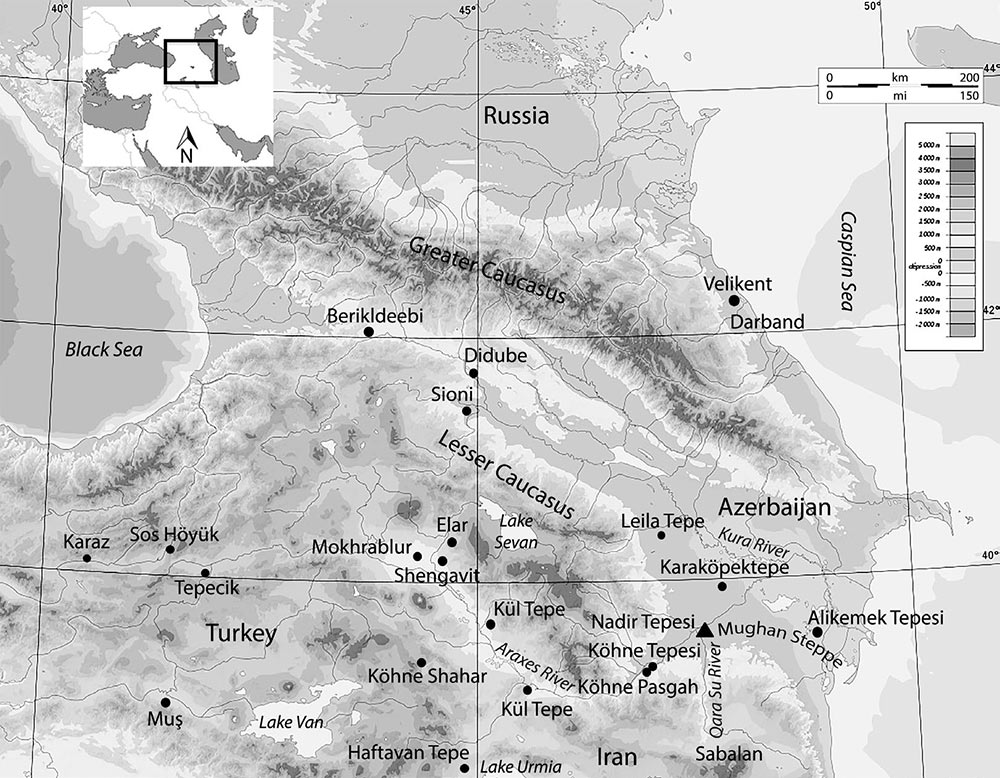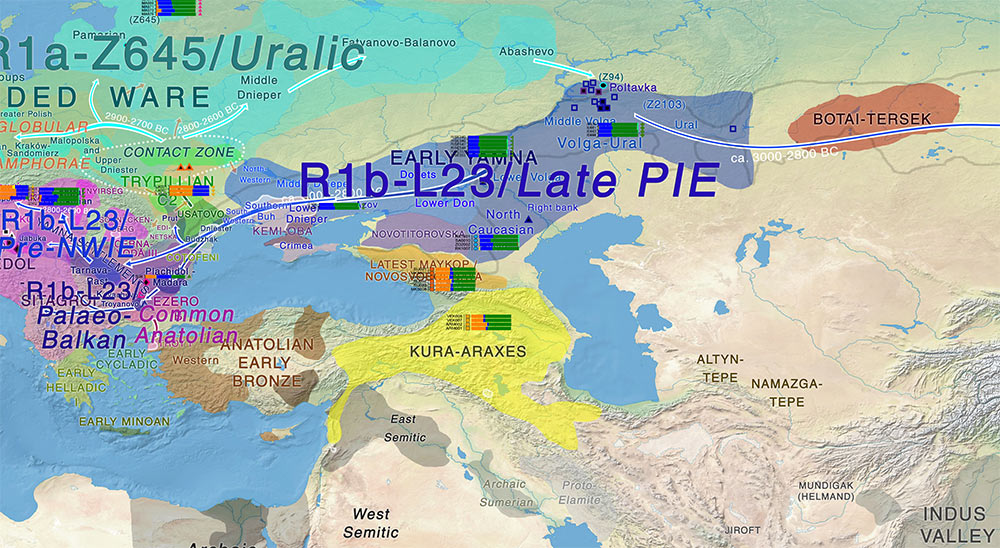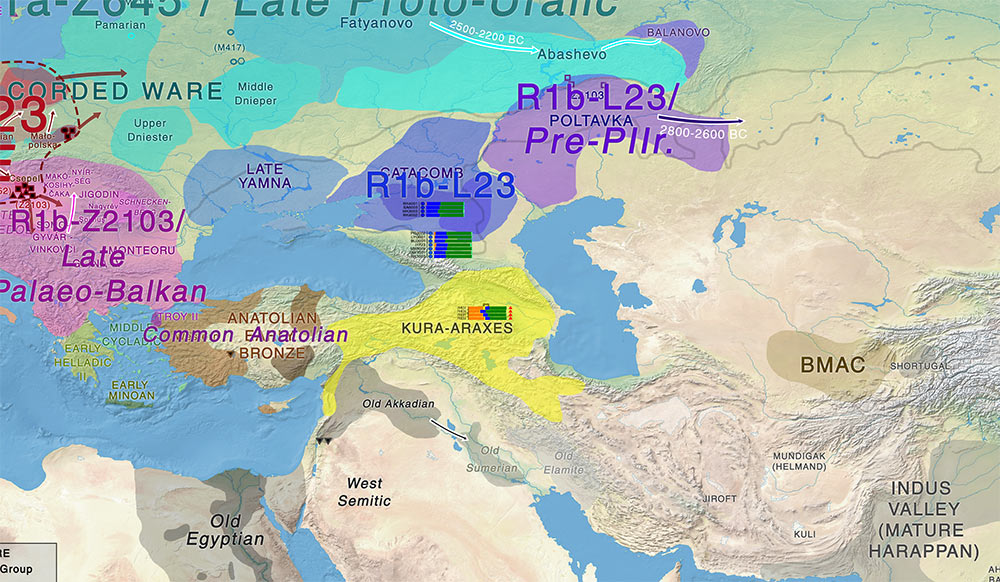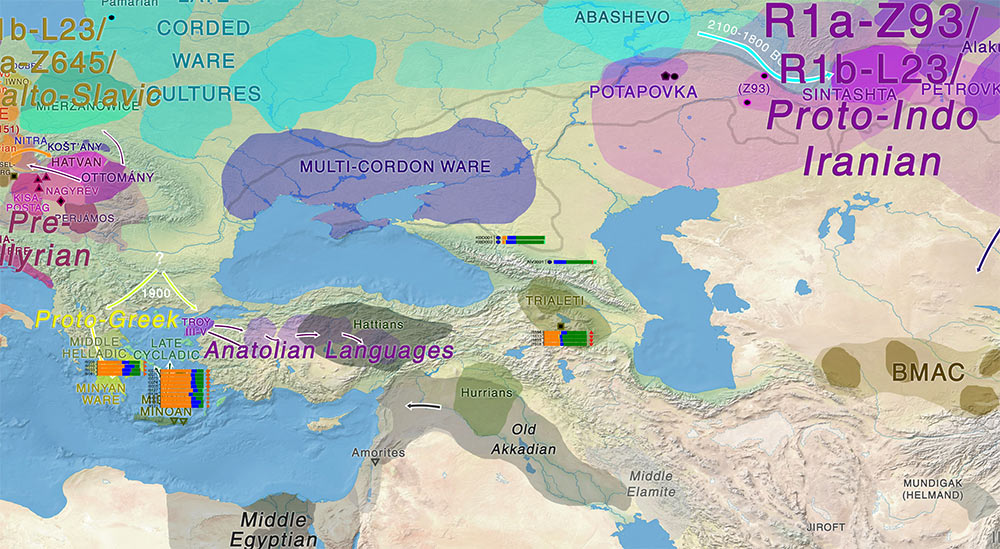Open access The End of the Kura-Araxes Culture as Seen from Nadir Tepesi in Iranian Azerbaijan, by Alizadeh, Maziar & Mohammadi, American Journal of Archaeology (2018) 122(3):463-477.
Interesting excerpts (emphasis mine):
The test trenches at Nadir Tepesi suggest that the Kura-Araxes occupation ended abruptly in the mid third millennium B.C.E. and that the site was then occupied or visited by a new group of people with new cultural traditions. Evidence for a significant destruction followed by the sharp discontinuity in the material culture could represent a violent termination of the Kura-Araxes occupation at Nadir Tepesi. This possibility provides one hypothesis for the end of the Kura-Araxes culture elsewhere as well in the Mughan Steppe.
It appears that there is no subsequent substantial built settlement until possibly the Late Iron Age in the region. Our intensive and extensive surveys on the Mughan Steppe did not provide evidence for settlements until long after the Kura-Araxes time. For whatever reason, settlements on the Mughan Steppe seem to have reappeared only in the Iron Age and remained sparse until the Sassanian period in late antiquity.45 Although some ceramics with parallels in the Middle and Late Bronze Age and the Iron Age were found at a few sites, they do not seem to represent settlements.

Indeed, except for the sites that may possibly contain burials, we do not know much about the Middle and Late Bronze Ages through the Iron Age in the Mughan Steppe. Similarly, archaeological investigations in the southern Caucasus do not provide information on settlements in the Middle Bronze Age.46 From a broad perspective, the abrupt and possibly violent end to the Kura-Araxes occupation at Nadir Tepesi, together with the sudden disappearance of the Kura-Araxes settlements and the scarcity of post–Kura-Araxes sites in the Mughan Steppe,47 may indicate that these changes were part of a larger phenomenon. This evidence could suggest a major sociocultural and demographic transformation at a regional level, at least in the western Caspian littoral plain, in the middle of the third millennium B.C.E. Other archaeological investigations in the southern Caucasus portray a similar picture, that of newcomers with a significantly different lifestyle and means of subsistence possibly associated with a mobile economy. Except in some elements of the ceramic traditions, evidence of continuity of Kura-Araxes traditions and their coexistence with newcomers is scarce and uncertain.48
On one hand, Puturidze argues that there is no evidence supporting the notion of a migration of people into the southern Caucasus.50 Rather, she associates all the changes in the post–Kura-Araxes period with influences from Near Eastern societies as a result of developing interactions by the end of the third millennium B.C.E. On the other hand, Kohl hypothesizes the possibility of a “push-pull process”51 in which new groups of people with wheeled carts and oxen-pulled wagons gradually moved from the steppes of the north into the southern Caucasus, and the Kura-Araxes communities subsequently moved farther south.52.

Kohl also reminds us of the evidence of increased militarism from the Early to the Late Bronze Age that is reflected in more fortified sites, new weaponry, and an iconography of war as seen on the Karashamb Cup.53 The appearance of defensive mechanisms such as fortification walls, which can be seen at Köhne Shahar, a Kura-Araxes settlement near Chaldran in Iranian Azerbaijan, further emphasizes the increase of intergroup conflicts and militarism during the Early Bronze Age, before the Kura-Araxes culture came to an end.54 Kohl argues that, while the number of Kura-Araxes settlements decreased in the southern Caucasus, archaeological research indicates that the Kura-Araxes culture spread to western Iran in the Zagros region and to the Levant.55 In Kohl’s view, as new groups of people moved in, the Kura-Araxes communities abandoned the southern Caucasus and moved farther south, where some of them already resided. Although some scholars suggest the possible movement of new groups of people from the northern steppes to the southern Caucasus,56 others associate the cultures of the post–Kura-Araxes period, especially the Trialeti.
We believe that the evidence supports a less uniform scenario. The Kura-Araxes culture may have disappeared in various ways; the transition to the post–Kura-Araxes time may not be explained by a single model. Different Kura-Araxes settlements may have ended differently. The evidence from Nadir Tepesi could support a violent end at that site, and it is possible that similar evidence will be found at other sites in the Mughan Steppe. At some sites, such as Köhne Tepesi in the Khoda Afarin Plain,58 the Kura-Araxes occupation also ended abruptly but without any sign of destruction. In other regions, there may be evidence supporting the coexistence of newcomers with Kura-Araxes communities for some period.59 The results from Gegharot60 in Armenia and recent excavations by one of the authors of this report at Köhne Shahar, do not support any of these models. At Köhne Shahar, the Kura-Araxes culture ended around the middle of the third millennium B.C.E.61 In the last phase of Kura-Araxes occupation at the site, six storage jars in one of the workshop units stood intact, five of them still carefully covered by stone slabs. The evidence from Köhne Shahar may point to a nonviolent end or a planned abandonment of the site.62

The picture continues to be somehow blurred for what happened in the Caucasus and North Iran after the Late Indo-European expansions, due to contradictory information.
With the analysis of the dataset from Narasimhan et al. (2018), it seemed that steppe peoples might have migrated into North Iran after the first Khvalynsk/Repin or Early Yamna expansions, because some samples from North Iran were reported to have steppe-related admixture.
NOTE. As I already said, the Hajji Firuz sample of R1b-Z2103 subclade (of uncertain date) clusters closer to the Iron Age sample F38 from Iran (Broushaki et al. 2016), of the same subclade, which is quite likely related to Proto-Armenian speakers, so it is possible that both belong to the same, Late Bronze Age / Iron Age group of migrants.
The other possibility, since it also clusters at a certain distance from the Hajji Firuz I4243 ‘outlier’, dated ca. 2326 BC (from the same archaeological site as other Chalcolithic samples, but being an intrusive Bronze Age burial), is that the Hajji Firuz sample is related to these hypothetical early migrations described here; or, that its date of I4243 is also not reliable…
These initial reports, coupled with archaeological descriptions of potential migrants from the steppe ending the Kura-Araxes culture, may suggest that peoples of steppe origin (or peoples with steppe admixture from the Caucasus) occupied territories further to the south (see here for potential early migration waves).
However, studies of samples from the Caucasus in Wang et al. (2018) have shown that no migrations related to EHG ancestry happened to the south, and that the minimal EHG/WHG contribution in Kura-Araxes individuals is probably part of the Anatolian farmer-related ancestry, and not from the steppe.
In fact, further contribution from Iran Chalcolithic-related ancestry was found intruding to the north during the Early Bronze Age, into Kura-Araxes and Maykop-Novosvobodnaya samples. In the Middle Bronze Age, some peoples from the North Caucasus show steppe ancestry (further to the south than the first steppe ancestry incursions of the North Caucasus piedmont), but most late Caucasus groups studied retain the ‘southern’ Armenian/Iran Chalcolithic profile.

All this casts doubts on the whole idea of intrusive steppe ancestry found in Iran Chalcolithic and Early Bronze Age (or, alternatively, on the proper dates of the Hajji Firuz ‘outliers’).
Also, the archaeological discontinuity in the region until the Iron Age, and the close relationship of Armenian to Greek (relative to other Palaeo-Balkan languages, which seem to have expanded to the south-west with Yamna settlers), does not support these hypothetical early steppe migrants as the Proto-Armenian community; earlier migrations of LPIE speakers without known modern descendants are obviously possible, but no clear archaeological or linguistic link has been offered to date to support this.
Until we have more samples with a clear archaeological and chronological context from Anatolia, Iran, and the Armenian Highlands during the Bronze and Iron Ages, and until they show clear steppe ancestry assessed in peer-reviewed papers (or at least thoroughly contrasted with other potential sources of such ancestry, and with solid statistical results), the question of intrusive steppe ancestry, and thus maybe LPIE-speakers (which may or may not be associated with Proto-Armenians) remains open.
NOTE. The Armenian question remains open, not because genetics has precedence over linguistics, but because the linguistic classification and date of separation, in this case, is not clear, and may be quite old. The fact that Palaeo-Balkan and Pre-Indo-Iranian might have separated quite early within the Khvalynsk – Volga-Ural (Early Yamna) community adds to the difficulty in assessing migration routes, although I do believe that the close similarity of Armenian with Greek among Palaeo-Balkan languages do not warrant such an early separation, and the Middle to Late Bronze Age period in the Balkans and Anatolia offers a better route for this expansion.
See also
- On the Maykop – Upper Mesopotamia cultural province, distinct from the steppe
- Steppe and Caucasus Eneolithic: the new keystones of the EHG-CHG-ANE ancestry in steppe groups
- The Caucasus a genetic and cultural barrier; Yamna dominated by R1b-M269; Yamna settlers in Hungary cluster with Yamna
- Consequences of Damgaard et al. 2018 (I): EHG ancestry in Maykop samples, and the potential Anatolian expansion routes
- No large-scale steppe migration into Anatolia; early Yamna migrations and MLBA brought LPIE dialects in Asia
- Proto-Indo-European homeland south of the Caucasus?
- On the potential origin of Caucasus hunter-gatherer ancestry in Eneolithic steppe cultures
- Consequences of O&M 2018 (II): The unsolved nature of Suvorovo-Novodanilovka chiefs, and the route of Proto-Anatolian expansion
- North Pontic steppe Eneolithic cultures, and an alternative Indo-Slavonic model